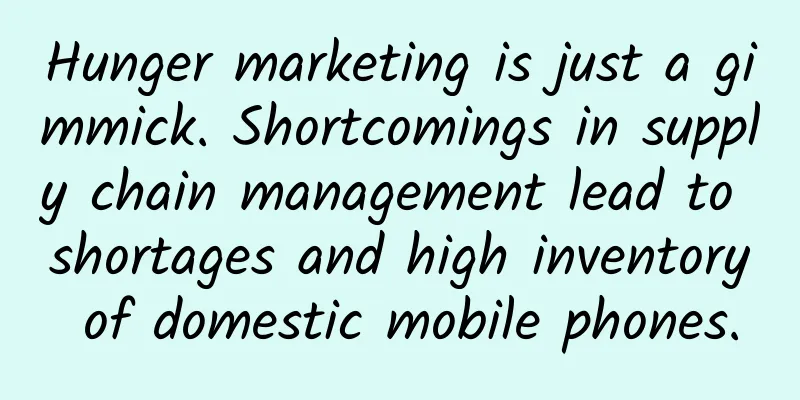Hunger marketing is just a gimmick. Shortcomings in supply chain management lead to shortages and high inventory of domestic mobile phones.

|
Industry insiders pointed out that there is no such thing as hunger marketing in the fiercely competitive electronic consumer goods industry. The real reason is inaccurate market forecasting and slow supply chain response. Compared with international companies, domestic mobile phone supply chain management is very weak, and many even have no management at all. From 2011 to 2014, the Internet mobile phones pioneered by Xiaomi led to an overall improvement in the quality, popularity and competitiveness of domestic mobile phones - but now, Internet mobile phones are lacking in momentum. This strategy of using ultra-high cost-effective products and Internet marketing as the core has forced domestic mobile phone manufacturers to move away from the past strategy of flooding the market with low-quality and low-priced products, and to learn from Xiaomi. But now, this business model has been fully understood, imitated, and quickly spread throughout the mobile phone industry. Moreover, the shortcomings of this business model are becoming more and more obvious, that is, this model is more suitable for thousand-yuan phones, and is not suitable for the mobile phone market above 2,500 yuan. Xiaomi, Meizu, and Smartisan have all used market data to prove this point. In 2015, Xiaomi was gradually criticized by the media for failing to meet sales expectations. In the first quarter of 2016, in the market report of international analysis agency IDC, Xiaomi fell from the top five to seventh. When the Internet model hits its ceiling, what will be the next turning point for domestic mobile phones? Since 2014, Huawei, as well as OPPO and vivo, which were once overshadowed by Internet mobile phones, have taken on the responsibility of domestic mobile phones. These mobile phone manufacturers with more than ten years of experience have the capabilities of component supply, R&D system, quality management, inventory management, etc. that Internet companies do not have. In the past six months, the three companies have repeatedly stated that the experience accumulated in these mobile phone manufacturing industries has enabled them to make great progress. Admittedly, this is their gene that distinguishes them from Internet phones. But if compared with Samsung and Apple, these manufacturers still have obvious shortcomings. How to get top suppliers? On April 6, 2016, Huawei released its new high-end flagship phone, the P9, in London. Its alliance with German camera maker Leica became the latest breakthrough. The Leica-certified dual camera stole the show, so much so that some consumers would ask for a Leica phone when they entered a Huawei experience store. What is not well known is that the cooperation between Huawei and Leica began three years ago, and Huawei Consumer Business CEO Yu Chengdong was personally in charge of this project. In 2013, Huawei had just determined the boutique route and released the first flagship phone at that time, the P6, which was widely praised. Before 2010, domestic mobile phones occupied the low end and generally adopted MediaTek's chip platform. They purchased domestic screens, batteries, cameras and other products to assemble mobile phones. The impression of low quality and low price was deeply rooted in people's minds. At this time, the advent of the iPhone allowed domestic mobile phones to enjoy the first wave of dividends from smartphones. Jobs let the world know that "a mobile phone should be made like this", providing a model for the industry to imitate. More importantly, the smartphone trend led by Apple eliminated traditional mobile phone giants such as Nokia, BlackBerry, and Motorola. In the following two years, mobile phone talents from Nokia and Motorola gradually poured into the domestic mobile phone camp including Xiaomi and Huawei. They became the pillars of the rise of domestic mobile phones, which was also the direct reason for the rapid improvement of domestic mobile phones in quality and appearance. High-end components used by European and American mobile phone giants such as LG, Sony, Toshiba, and Qualcomm also turned their attention to Chinese manufacturers with the decline of Nokia and Motorola. It was during this period that Xiaomi secured cooperation with top suppliers such as Qualcomm and Sharp. "However, this cooperation is obviously different from their cooperation with Apple," a Huawei department head told reporters. "The top hundreds of device vendors only look at the roadmaps of Samsung and Apple. After their products enter Apple and Samsung, they will ask, 'Do you want to use Huawei?' The gap between them can be best felt from the top suppliers." In order to solve this gap, Huawei recruited scientists in the field of components and frequently communicated with top suppliers, trying to incorporate Huawei's roadmap into the research and development routes of top suppliers. "These suppliers are starting to consider Huawei while targeting Samsung and Apple, so that Huawei can dilute the influence of the two companies and get a certain exclusive window." The Huawei person in charge told reporters: "It takes at least three years to get a component supplier, one year for technical verification, one year for trial production, and one year for mass production." Just like Leica, Huawei took three years to finalize the exclusive cooperation with Leica. "Of course, it is not enough to just get the components. Each high-end component, such as cameras, batteries, touch screens, fingerprint recognition chips, and GPS, requires a dedicated driver and corresponding software optimization algorithms to achieve the best results," Thundersoft Vice President Yang Yuxin told reporters. "The accumulation of these software algorithms also requires R&D personnel and a large amount of capital investment, which takes 2-3 years. Most of the algorithms of Apple and Samsung are developed by their own teams, and domestic manufacturers are just beginning to accumulate." The above-mentioned Huawei person also said: "To make a breakthrough in software, we may need to invest more energy." ThunderSoft is one of the few domestic Android mobile phone software providers, developing drivers and algorithm optimization for components such as cameras, WiFi, Bluetooth, and audio. ThunderSoft went public at the end of 2015, and its share price soared from 33 yuan to 220 yuan today. There is no hunger marketing Not only do domestic mobile phones have to go to great lengths to improve their supply chain, but they also have a clear gap in overall supply chain management compared to Apple. Xiaomi, Smartisan and other mobile phones are often featured in supply chain management classes as alternative cases. Some of Xiaomi's products were in short supply for a long time, which was once interpreted by the industry as "hunger marketing"; while Smartisan once purchased the most advanced components and used the top Foxconn for OEM, but paid the price of extremely low yield rate. "In fact, there is no such thing as hunger marketing in the fiercely competitive electronic consumer goods market. The real reason is inaccurate market forecasting and slow supply chain response," Liu Baohong and Liu Rongjun, two well-known experts in supply chain management, told reporters. "Compared with international companies, domestic mobile phone supply chain management has obvious shortcomings, and many even have no management at all." Liu Baohong said: "The shortage of electronic products is partly due to inaccurate market forecasts, but more importantly, there is no emergency plan for potential situations, and naturally there is no executable plan." Liu Baohong once worked in supply chain management for a US semiconductor giant. He said: "Although Apple was out of stock from time to time in the early days, it solved the problem very quickly." In 1997, Jobs poached Cook from Compaq to be responsible for Apple's supply chain. At that time, Apple's components and assembly plants were extremely scattered, and Cook closed production facilities in the United States and Ireland, activated contract manufacturers in Asia, established a JIT inventory system, etc., laying the foundation for iPod and iPhone. In addition, Liu Rong, a well-known supply chain management expert, also told reporters: "The supply chain management methods of domestic mobile phone manufacturers cannot support the rapid response of production capacity." "Domestic mobile phone manufacturers almost all adopt the cost management method. The most obvious indicator is the 'cyclical reserve requirement ratio', which is the percentage point by which prices must be reduced within a quarter or cycle. Suppliers are treated as opponents in the interest game." Liu Rong said, "Therefore, suppliers have no profit to improve their ability to respond quickly. There are thousands of materials in a mobile phone. As long as a few cannot respond, the manufacturer cannot temporarily increase production capacity and has no flexible supply capability." What makes Liu Rong embarrassed is that "every time I teach supply chain courses, the business people who come are basically 'purchasing directors'. It's rare to see positions like 'supply chain directors'. Occasionally, when I see a few, they are all doing the same procurement work of asking for prices and bargaining." Inventory is the devil The shortcomings in supply chain management lead not only to “hunger marketing” but also to worrying inventory. At present, Apple is the mobile phone manufacturer with the highest inventory turnover efficiency. According to the calculation formula of (inventory/sales cost) × 360 days, Apple's turnover days have remained at 5-6 days in the past few years. Among mobile phone manufacturers, Samsung's inventory turnover days were 20.3 days in 2015. Previously, Nokia, Motorola and other mobile phone companies also maintained inventory turnover days of around 20 days at their peak, which shows Apple's horrific efficiency. However, the inventory days of domestic mobile phones are much higher than this. According to Huawei's financial report, in 2015, Huawei's inventory turnover days were 94 days, and in 2014, Huawei's turnover days were 104 days. However, this turnover number includes products with longer inventory cycles, such as telecommunications equipment and enterprise network equipment. The reporter checked the financial reports and found that in 2015, the inventory turnover days of telecommunications giant Ericsson was 64 days, and the inventory turnover days of enterprise network company Cisco was 28.6 days, both of which were more efficient than Huawei. In fact, in an interview with reporters, Liu Baohong and Liu Rong both said: "Huawei is already the company with the best supply chain system in China." As early as 1997, Huawei began to cooperate with IBM to launch the ISC (Integrated Supply Chain) management reform, which greatly improved the efficiency of telecommunications business. Since 2013, Huawei's consumer business has carried out supply chain management system construction through the Blue Ocean Transformation Project and launched the ATO and STO supply management models. However, Huawei still mentioned in its New Year's speech for terminal business that "ITO inventory management has large problems and high risks." "Comparing the turnover days of Huawei and Apple, Apple's cash flow speed is at least 15 times that of Huawei," Liu Rong introduced: "In other words, under the same profit margin, Apple's profitability is 15 times that of Huawei." In 2015, Huawei's profit margin was 11% and Apple's profit margin was 22%. Apple's profitability was 30 times that of Huawei. "The fewer models, the simpler the supply chain system, and the easier it is to control inventory," Lao Yao, secretary general of the China Mobile Alliance, told reporters. "In the beginning, when Xiaomi had a single product, the inventory turnover efficiency was also very high. But in the past two years, with more and more Xiaomi models, inventory is bound to be longer and the risk is higher." In fact, since 2015, the pace of new product releases by domestic mobile phone manufacturers has significantly accelerated, while the life cycle of a new model has been rapidly shortened. A person from a mobile phone manufacturer said: "Products that used to sell for 4-5 months now have obvious inventory after 3 months, so everyone can only keep releasing new models to attract customers." The insider believes: "With the increase in aircraft models and suppliers, and the need to invest in logistics and channels in the international market, management bottlenecks have become increasingly apparent." As a winner of Toutiao's Qingyun Plan and Baijiahao's Bai+ Plan, the 2019 Baidu Digital Author of the Year, the Baijiahao's Most Popular Author in the Technology Field, the 2019 Sogou Technology and Culture Author, and the 2021 Baijiahao Quarterly Influential Creator, he has won many awards, including the 2013 Sohu Best Industry Media Person, the 2015 China New Media Entrepreneurship Competition Beijing Third Place, the 2015 Guangmang Experience Award, the 2015 China New Media Entrepreneurship Competition Finals Third Place, and the 2018 Baidu Dynamic Annual Powerful Celebrity. |
>>: From the hit of "Ode to Joy" to how video websites grasp the lifeline of drama selection
Recommend
What are some tips you can think of for animals to keep cool in the summer? For example, peeing on their feet...
"Hot! Hot!" As all parts of China enter...
40℃ is not over yet! This summer may be hotter than ever before!
Audit expert: Zhan Mingjin PhD, Chinese Academy o...
Taking Pinduoduo as an example, we will analyze the paid membership tier model and operation ideas
This article takes the mainstream payment system ...
Traffic acquisition methodology!
I would like to share some experience in traffic ...
Weekly crooked review: To be honest, how old are you if you keep talking about the cold winter?
In the past, the transportation was slow, the let...
From 47% to 80%, Ctrip Hotel APP Fluency Improvement Practice
Author: Jin, senior R&D manager at Ctrip, foc...
China Mobile APP Advertising Fraud Analysis Report
PC is disappearing from our daily life scenes at ...
Do you only know the funnel model for conversion rate analysis? You can also use these
What is a conversion? 1. Conversion rate Let’s ta...
Understand the universal formula for traffic generation and you won’t have to worry about lack of traffic!
I have seen too many people pursuing various meth...
How can I promote more cost-effectively in Baidu SEM?
Now Dongguan Feng Chao editor has found that more...
Maimai’s road to 25 million users: Since social networking is not good enough, let’s make a real-name content community
Every smartphone user must be familiar with these...
Will drinking ice water often hurt your stomach? Will drinking hot water be fine?
Reviewer of this article: Chen Haixu, Deputy Dire...
Make intelligence simpler and teach you how to use Xiaomi TV 2 Elderly Mode
At present, many technological products are insep...
"2019 China Automobile Product Quality Performance Study" deeply analyzes the overall quality performance and trends of domestic mainstream automobile products
In order to solve consumer pain points, help OEMs...
Marketing promotion: How to improve promotion effectiveness by outputting excellent creative ideas?
With the upgrading of consumption, Chinese people...









